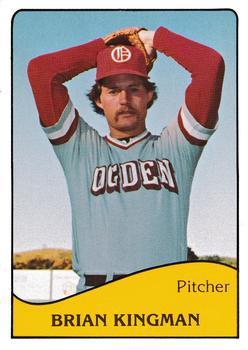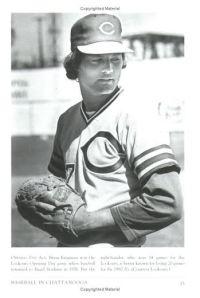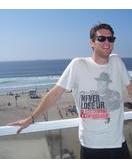
Brian, just a young buck in the “bushes”.
This is the first part of what will eventually be a 4 or 5 part series interview with former Athletics pitcher Brian Kingman. I know this is the part where I usually talk incessantly about nothing, but I’ll let the man speak for himself. I will, however, add that Brian was gracious enough to give me some in -depth answers that read like a book. This is good stuff readers! I hope you enjoy this as much as I did.
1) Well, I suppose we should start at the very beginning. I have a sort of strange obsession with the life of a minor leaguer. The trials, tribulations and bus rides in the “bushes” always stoked my imagination. Do you have any stories or thoughts about any of your stops in the minors? LIFE IN THE MINORS “The price of anything is the amount of life you exchange for it” ~Henry Thoreau Baseball has always been a game of numbers, and some of the biggest numbers are the odds against making it to the big leagues. Less than one percent of high school players and about five percent of college players are drafted. Less than ten percent of minor leaguers will play even one day in the major leagues and somewhere between 1-2 percent will actually have a career in the big leagues. I think my first day of spring training the Director of Minor League Operations said something similar to this in a speech to all of the Oakland A’s minor league players. I am sure virtually all of us were confident that we were among the 1-2 percent. If we weren’t, we probably wouldn’t have made it this far. Knowing that you will make it to the major leagues makes it easier to endure the grind, which is the grueling schedule of 140 or so games,10 hour bus rides, cheap hotels, doing your own laundry, missing your girl friend, and crappy food. This was just another obstacle to be over come on the path to the big leagues. You were no longer just playing baseball, you were being paid to play baseball. So what if you made less than $10,000 a year, you were living the dream. Actually as I always liked to point out, we were chasing the dream. Living the dream would be life in the major leagues. The fact that professional baseball was different from the baseball you had played up to this point in your life was quickly apparent. There were far more players in spring training than there were rosters spots in the minor league system. Almost every day a few players would get to their locker in the morning ready to start their day, only to notice that their locker was empty. The only thing in their locker would be a pink slip informing them to see their manager. The pink slip mean that they were released. In the real world it would be referred to as being fired or terminated. For all but a few who might catch on with a different organization it mean that their days of playing baseball were over. Most of these guys had been playing baseball since Little League, and had been stars in high school or college. As the season drew closer and the certainty over roster spots became more clear, it was common for the pranksters to remove the contents of one of the remaining players locker and place a forged note in their locker instructing them to see the manager. The locker room would be full of somber faces and condolences regarding the bad news. More than a few guys fell for it hook, line and sinker, some of them near tears as they walked into the managers office only to learn it was all just a joke. I remember reading in a book (Outliers, by Malcolm Gladwell) that one of the elements involved in the development of excellence at performing complex tasks is to have spent at least 10,000 hours of practicing it. In order to achieve the level of mastery associated with being a world class musician, chess player, baseball player – anything, you basically have to spend at least 10,000 hours working at it. That’s one of the reasons why to excel at something you need to really like what you are doing, or the odds are you won’t put in the hours. For most of the guys who were cut in spring training, they had put in 10,000 hours working at something they loved, there just happened to be an excess supply of baseball players competing for a limited number of spots. The ten thousand hour rule might get you a spot in the minors, but to continue along the path to the big leagues it is just a prerequisite. My first full season in the minor leagues was spent in the Southern League. The Athletics double A team was the Chattanooga Lookouts.
Kingman in Chattanooga
When
welanded at the airport in Chattanooga there was a crowd waiting to greet us, and a parade that took us to our home park, Engel Stadium. It had been eleven years since professional baseball had been played in Chattanooga, and the city was elated to have a team once again. Engel Stadium had quite a history. Satchel Paige made his professional debut at Andrews Field, future site of Engel Stadium, in 1926, playing for the Chattanooga White Sox, a negro league team. Twenty one years latter,16-year oldWillie Mays made his professional baseball debut as a center fielder for the Chattanooga Choo-Choos in the Negro Southern League at Engel Stadium. Harmon Killebrew also played there. He is the only player ever to hit a ball over the centerfield wall which was 471 feet from home plate! It is 325 feet down the line to left and probably 340 feet or so to the scoreboard, which was over 30 feet tall. I spent the first half of the season trying to fungo balls over the scoreboard before I finally succeeded. No one had hit a ball over the scoreboard in a game, although Dale Murphy almost hit a ball through it one night. The combination of throwing a lot of innings and swinging a bat has hard as I could a countless number of times eventually took its toll on my elbow. Engel Stadium is no longer used for minor league games, it was however used in the filming of 42, the Jackie Robinson story. The bus rides in the Southern League were long. Sometimes we would leave after a night game at midnight, endure a 10 hour bus ride which arrived at 10 am in the next city, with a game at 7pm that night. I’d say the average bus ride was6-7 hours, but there were several 10 and 11 hour rides in the mix. Players in the minor leagues spend a lot of time together. In addition to sharing an apartment, you had a roommate on the road, all that time on the bus, and of course at the ballpark. We also shared a common goal which was to make it to the big leagues. Professional baseball is a way of life. During the season you eat, sleep and drink baseball. It is like a parallel universe to the real world. Players become totally absorbed in mastering the skills they need to be successful. Almost everyone in the minor leagues was able to dominate the competition in amateur baseball. Now for the first time many minor league players have to learn how to transcend failure, something they may have never experienced before. For someone who was never hit below .400 in their life it can be quite humbling when your struggling to hit .250. In order to play in the major leagues you not only need the physical skills, you need to be mentally tough. Days off were few and far between but that didn’t stop us from having fun. While it is true that there were very few off days, there was still plenty of time for mischief. Games typically ended at 10pm, bars closed at 1 and you could sleep till noon if you wanted to most of the time. Some organizations, like the Dodgers were known for their discipline, dress code and curfews. The A’s organization was at the other end of the spectrum. This remained true even when I reached the major leagues. Billy Martin encouraged his players to drink, in fact if you weren’t a drinker he thought there was something wrong with you. In Billy’s view there was no better way to celebrate the thrill of victory, or to drown the agony of defeat than by closing down the bar. Playing baseball in many ways allows you - for better or more likely worse! – to have an extended adolescence. Teams tend to get more out of control on a road trip. After a game ends players need to unwind. Food, alcohol and women always seem to go a long way to alleviating, hunger, boredom, loneliness, horniness and even depression. The good news was the necessities always seemed to be readily available. If left completely unsupervised I am sure our hotel would have turned into something resembling a party from the movie Animal House.“Being with a woman all night never hurt no professional baseball player
It’s staying up all night looking for a woman that does him in” ~ Casey Stengel Fortunately for baseball, and minor league teams every where, the minor league manager always seems to be around to keep things from getting too far out of control. Minor league managers have to be able to manage more than just the game. They also teach how the game should be played and are instrumental in passing on the oral traditions of the game:The 1976 was a fun season with a lot of great memories. Matt Keough was still an infielder, and played third base. Steve McCatty was our closer, and Dwayne Murphy was the centerfielder. Bruce Robinson was my catcher and closest friend on the team. Bruce caught for the A’s in September of 1978, and was traded to the Yankees in 1979.

You used to say that it was so easy
But you’re trying, you’re trying now
Another year and then you’d be happy
Just one more year and then you’d be happy
But you’re crying, you’re crying now

